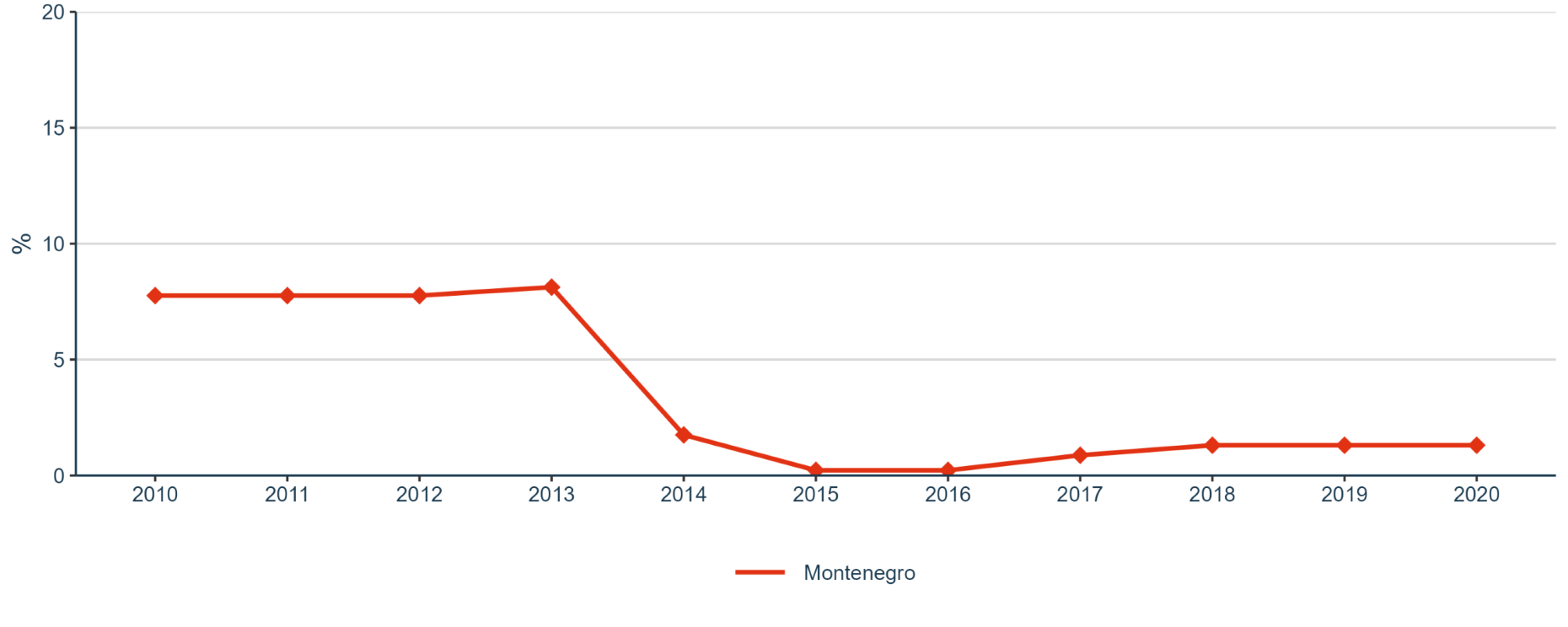ERA Country Report 2023
Montenegro
Edited by Domagoj Racic (Independent Science, Technology and Innovation policy expert)
as part of ‘Development of the ERA Scoreboard, the ERA Dashboard and the Regular Reports’ project for the European Commission, Directorate-General for Research and Innovation under Framework Contract N° 2018/RTD/A2/OP/PP-07001-2018 Lot 2 (EDAR)
Click here to download this country report![]()
- Table of contents
-
ERA Country Report 2023: Montenegro
1. National context
1.1. Overview of the ERA policy agenda implementation
1.2. Policy context
2. Assessment of the Implementation of the ERA Policy Agenda and ERA Priorities
2.1. ERA Priority 1: Deepening a truly functional internal market for knowledge
2.2. ERA Priority 2: Taking up together the challenges posed by the twin green and digital transition and increasing society’s participation in the ERA
2.3. ERA Priority 3: Amplifying access to research and innovation excellence across the Union
2.4. ERA Priority 4: Advancing concerted research and innovation investments and reforms
3. Country-specific drivers and barriers
4. Final remarks
5. Bibliography
6. Annexes
6.1. Annex 1: Graphs
ERA Country Report 2023: Montenegro
|
Key takeaways:
|
1. National context
1.1. Overview of the ERA policy agenda implementation
According to the European Innovation Scoreboard 2023, Montenegro is an Emerging Innovator performing at 47% of the EU-27 average. Its performance is improving at a rate just below that of the EU-27 (8.5% percentage points) and is under the average of the Emerging Innovators. In this context, the country’s performance gap with the EU-27 increased in recent years.
Regarding the ERA Policy Agenda, Montenegro has yet to commit to the ERA Policy Agenda actions, but its R&I policy has been moving towards ERA priorities. The Smart Specialisation Strategy of Montenegro 2019-2024 as well as the Strategy for Scientific Research Activities ^ play pivotal roles in the R&I system.
In general, Montenegro is at a good level of preparation in science and research due to the implementation of the smart specialisation strategy, increasing participation in the Horizon Europe programme, and increasing government spending on science and innovation in 2023 (Chapter 25). ^ ^
The key responsible institution for the development and implementation of the R&I system and policies is the Ministry of Science and Technological Development. The Ministry of Education is responsible for higher education institutions. The research projects these ministries manage are financed from the national budget, whereas innovation activities are financed through the Innovation Fund.
In 2020, the Ministry of Education adopted the Programme for the Implementation of Open Science Principles with the Action Plan (2020-2022). ^ The Development Strategy for micro, small and medium-sized enterprises in Montenegro 2023-2026 with Action Plan, ^ the Intellectual Property Strategy 2023-2026 with Action Plan for 2023 and the Innovation Programme 2023-2027 were adopted in July 2023. The Strategy of Higher Education of Montenegro for 2023-2026 was drafted and submitted for public consultation. The Strategy for Scientific Research Activities, which will define the research funding models and instruments to increase the number of researchers, is being developed incorporating ERA priorities.
Simultaneously, a new Law on Scientific Research Activity is being drafted. The current law regulating research is the Law on Scientific Research Activity from 2010 (amended in 2011, 2014 and 2020). Laws regulating innovation include the Law on Innovation Activity and the Law on Incentive Measures for the Development of Research and Innovation adopted in 2020.
As for the priorities for 2023, the emphasis was on the further advancement in the implementation of the Smart Specialisation Strategy. One of the main objectives is to make the Innovation Fund fully operational, strengthening science-industry cooperation structures and further supporting the knowledge transfer between them. In addition, it aims to increase the investment in research and innovation programmes and participation in the Horizon Europe programme while fostering the participation of women. An increased budget in the R&I area is necessary to support economic recovery and competitiveness while helping tackle the brain drain of researchers and other younger experts and professionals.
2. Assessment of the Implementation of the ERA Policy Agenda and ERA Priorities
Although Montenegro has not committed to any ERA action, some activities contribute to its R&I development in the European context. The rest of the section will focus on the progress observed, as measured by the indicators in each ERA Priority Area.
The quantitative information presents the most recent data for the ERA Scoreboard and ERA Dashboard indicators. However, in some cases, the data available pre-dates the ERA Policy Agenda. This report will serve as a baseline for reporting in the future. Therefore, the longer-term trends covering the last ten years are presented. It should also be mentioned that the data related to many indicators are unavailable, limiting the conclusion that can be drawn. The indicators falling under each ERA priority are presented below, and the general indicators are outlined in Table 1. More detailed information on the data and graphs can be found in Annex 1.
|
Indicator |
Most Recent Metric |
|
Gross Domestic Expenditure on R&D (GERD) as a percentage of GDP |
0.5 (2021) |
|
Researchers (in full-time equivalent) per million inhabitants |
4,763.5 (2021) |
|
Business Enterprise expenditure on R&D (BERD) as a percentage of GDP |
0.2 (2018) |
Source: compiled by research team based on the ERA Scoreboard and ERA Dashboard indicators
2.1. ERA Priority 1: Deepening a truly functional internal market for knowledge
2.1.1. State of play in the implementation of the ERA Actions
Montenegro has engaged with the different topics covered under ERA Priority 1 through national strategies focused on the specific areas of R&I.
In relation to ERA Action 1: Enable Open Science, including through the European Open Science Cloud (EOSC), since 2018, the Ministry of Science has been allocating funds to co-finance the publication of papers by Montenegrin researchers in open access journals. ^ Additionally, and covering ERA Action 2: Propose an EU copyright and data legislative framework for research, Montenegro participates in the European Open Science Cloud (EOSC). Although such engagement is currently limited, the country aims to promote European collaboration on research data.
In 2010, three out of four universities in Montenegro signed declarations of endorsement of the European Charter and Code for Researchers. ^ In this sense, the country is establishing new initiatives surrounding ERA Action 4: Promote attractive research careers, talent circulation and mobility. However, the internationalisation of the labour market for researchers is low in Montenegro.
In terms of the ERA Action 8: Strengthen research infrastructures. Montenegro´s main research infrastructure is the Innovation and Entrepreneurship Centre (IEC) Technopolis. It is composed of a laboratory, a data centre and a Techlab, and is supported by different national ministries and the Investment and Development Fund. Moreover, a partnership between the Government of Montenegro, the national Ministry of Science and the University of Montenegro developed the Science and Technology Park (STP) Montenegro, an innovation process instrument to promote entrepreneurship and start-ups.
Montenegro has also improved on gender and inclusion initiatives and is aligned with ERA Action 5: Promote gender equality and foster inclusiveness. In 2021, the government implemented the 2021-2025 National Strategy for Gender Equality and the final Report on the Implementation of the 2017-2021 Action Plan for Achieving Gender Equality. These projects aimed to promote gender equality in Montenegro and to protect women´s rights in all areas, including the research and innovation system. However, there are still challenges related to the labour market as the legislation on gender is limited.
To improve the country´s position in the R&I international environment in relation to ERA Action 7: Upgrade EU guidance for a better knowledge valorisation, Montenegro supports the Guiding Principles for Knowledge Valorisation developed through Horizon Europe. The country engages with this initiative through financial support via open calls and the National Contact Points network. This initiative also promotes collaboration within the European countries and relates to ERA Action 9: Promote international cooperation. The country joined the European Alliance of Innovation at the European level while engaging in new international agreements with R&I institutions of neighbour countries such as the Founder Institute of Serbia.
2.1.2. Progress towards achieving ERA Priorities
Within Sub-priority 1.1: Open science, when it comes to the share of open access scientific publications in total scientific publications, Montenegro´s performance between 2009 and 2019 has deteriorated. In 2019, the value for Montenegro was 40.84% (Figure 4 in Annex 1).
Regarding Sub-priority 1.3: Gender equality, equal opportunities for all and inclusiveness, the proportion of papers with mixed gender authorship has experienced some slight changes during the last decade. Although the proportion of mixed gender authorship remained around 40%, the values overall increased from 2010 to 2020 (Figure 5 in Annex 1). The proportion of women in authorships of the 10% most cited publications has fluctuated in Montenegro consistently from year to year, reaching the peak in 2016. As seen in Figure 6 in Annex 1, the latest available data in 2018 is around 38%.
In Sub-priority 1.4: Researchers’ careers and mobility and research assessment and reward systems, the only available indicator is Job-to-job mobility of Human Resources in Science & Technology. In 2011 it reached 5.8%, but has been declining ever since. In 2020, it registered a value of 3.4%, probably due to the pandemic (Figure 7 in Annex 1).
In the area of Sub-priority 1.6: Scientific leadership, Figure 8 in Annex 1 shows that Montenegro’s share of scientific publications among the top-10% most cited publications worldwide in all publications is very variable but at a relatively low level. In 2020, it was 4.2%. On the other hand, the Academic Freedom Index has traditionally been relatively low but increased sharply in 2021 (Figure 9 in Annex 1).
Sub-priority 1.7: Global engagement is measured by the number of international co-publications with non-EU partners per 1,000 researchers (Figure 10 in Annex 1), which has been growing consistently in Montenegro, reaching a 736 in 2022.
2.2. ERA Priority 2: Taking up together the challenges posed by the twin green and digital transition and increasing society’s participation in the ERA
2.2.1. State of play in the implementation of the ERA Actions
Montenegro has developed a number of initiatives to strengthen the national R&I environment aligned with the ERA Priority 2 Actions.
In terms of ERA Action 10: Make EU research and innovation missions and partnerships key contributors to the ERA, Montenegro is one of the members of the EU Climate and Smart Cities Mission. ^ This mission covers the lighthouse research infrastructure project that focuses on sustainable materials, clean energy, health and circular economy. The project is developed in six different areas monitored by key leading institutions. ^
Regarding ERA Action 11: An ERA for green transformation and ERA Action 12: Accelerate the green/digital transition of Europe’s key industrial ecosystems, Montenegro is now preparing a new strategic cycle focused on Healthy, Sustainable and Digitalised Montenegro. ^ This is supported by the Smart Specialisation Strategy of Montenegro 2019-2024 that establishes energy and sustainable development as one of its main priorities. Additionally, the government adopted the Programme for Innovation 2021-2024 for enterprise innovation, sustainable work and technology transferability. ^ It is promoted and funded mainly by the National Innovation Fund.
ERA Action 13: Empower Higher Education Institutions is led by the University of Montenegro. In recent years, the institution has promoted the implementation of new initiatives and more efficient strategies to improve the position of HEIs in the country’s R&I environment. Recently, the University of Montenegro has collaborated with the University Mediterranean and the University Donja Gorica in the development of the Internationalisation Strategy for 2021-2026. ^ It aims to promote the recognition of the Montenegrin R&I system while encouraging academic mobility, investment in research, and the acknowledgement of the role of HEIs for the country. ^
Among the efforts towards ERA Action 14: Bring Science closer to citizens, Montenegro participates in the Digital Agenda Observatory. ^ More specifically, the project on Civil Engagement in the Digital Agenda (ICEDA) managed by the observatory, aims to bring civil society organisations close to science and technology.
2.2.2. Progress towards achieving ERA Priorities
With regard to progress towards Sub-priority 2.1: Challenge-based ERA actions, the only available indicator (and only for some years between 2011 and 2017) is OECD patents on environment technologies. During this time, Montenegro did not show a consistent trend. In 2017 it had a value of 9.38, as observed in Figure 11 in Annex 1.
Sub-priority 2.3: Synergies with sectorial policies and industrial policy in order to boost innovation ecosystems is tackled through direct and indirect government support through R&D tax incentives as a percentage of GDP. Its value in Montenegro in recent years is barely above zero (0.0009%) (Figure 12 in Annex 1).
With regard to progress towards Sub-priority 2.4: An active citizen and societal engagement in R&I in all its dimensions, the indicator research on social innovation for Montenegro remains at 0, except in 2012 when it got to 1.6 (Figure 13 in Annex 1).
2.3. ERA Priority 3: Amplifying access to research and innovation excellence across the Union
2.3.1. State of play in the implementation of the ERA Actions
In relation to ERA Action 16: Improve EU-wide access to excellence, the country has been investing efforts into reaching out to its research diaspora and including them in R&I projects to promote excellence. Additional activities in international cooperation started in April 2022, with Montenegrin engagement with the European network of leading national innovation agencies (TAFTIE). In addition, to enhance its position at the international level, Montenegro has committed to the New European Innovation Agenda which aims to improve the process of the green transition and increase R&I adaptability in this regard.
2.3.2. Progress towards achieving ERA Priorities
In relation to progress towards Sub-priority 3.1: More investments and reforms in countries and regions with lower R&I performance, the relevant indicator is the increase (in percentage points) of total R&D expenditure expressed as a percentage of GDP. After several years of stagnation, Montenegro has managed to increase its gross spending on R&D to 0.50% of GDP in 2018. However, the level remained the same in all subsequent years until 2021 (Figure 14 in Annex 1).
2.4. ERA Priority 4: Advancing concerted research and innovation investments and reforms
2.4.1. State of play in the implementation of the ERA Actions
The Collaborative Grants Programme implemented by the Innovation Fund supports the cooperation of micro-enterprises and SMEs with scientific research institutions and other companies on commercially oriented innovative projects. ^ The private sector reduces some of the gaps created by the overall low level of R&D spending, which may indicate that an increase in public sector investments could also create crowding-in effects and synergies in science-industry collaboration. In this context, increased funding for R&I creates positive externalities, including increased participation in Horizon Europe. ^
Moreover, in relation to ERA Action 19: Establish an ERA monitoring system, the Statistical Office of Montenegro (MONSTAT) is recognised by both the public and private sectors as the official monitoring mechanism in terms of data of the country. It collects, analyses and disseminates the information on different fields such as the innovation activities of enterprises while being aligned with European bodies like Eurostat.
2.4.2. Progress towards achieving ERA Priorities
Within Sub-priority 4.1: Coordination of R&I investments, the key indicator is the share of public R&D expenditures financed by the private sector (Figure 15 in Annex 1). The share of R&D expenditure by the private sector was relatively high until 2013, but it decreased between 2014-2016. Since then, it has grown slightly until 2020, which should be put in the context of very low gross R&D expenditures in Montenegro.
3. Country-specific drivers and barriers
Montenegro is a candidate country for EU membership, building cooperation with EU institutions in various areas, including research and innovation. Montenegro became a fully associated to Horizon Europe in January 2021.
Montenegro has implemented new reforms for the efficient development of the R&I system. In January 2023, a coordination body was set up at the management level in the Ministry of Economic Development and Tourism to ensure consistency of the industrial policy with other national strategies and programmes. The advancement of Montenegro towards the ERA policy objectives will primarily be determined by its capacity to prioritise R&I within the policy agenda, mobilise resources, and reform its R&I system. As mentioned above, higher public sector R&I investments could lead to crowding-in effects and synergies in science-industry collaboration.
Furthermore, adopting key strategies and laws, setting up the Innovation Fund, and increasing international cooperation within ERA are important steps in that direction. International development actors could provide additional assistance for capacity building and increase the available resources. ^ Through the involvement in programmes such as Horizon Europe, the country can improve its position on ERA while boosting innovation, gender inclusion and international competitiveness. ^
Government commitment to R&I investments and reforms may be a prerequisite for tangible advancements towards ERA. Its progress in R&I seems slowed down due to the lack of resources and a long period of political instability. ^ The European Innovation Scoreboard 2023 identified both the government support for business R&D and R&D expenditures in the business sector as relative weaknesses of the R&I system. The low level of investment in research, development and innovation signifies not only the lack of resources but also a weak political commitment to R&I as a driver of competitiveness and economic growth. ^
4. Final remarks
Despite not having committed to the ERA Policy Agenda actions, Montenegro has developed and is implementing strategies and policies that contribute to ERA Policy Agenda implementation. It is primarily related to the adoption of the Strategy for Scientific Research Activities and the implementation of the Smart Specialisation Strategy, which strengthen the academia-business cooperation and support knowledge transfer between them. ^
Regarding Montenegro’s progress against the ERA indicators, the country has experienced fluctuations in the indicators under ERA Priority 1. In terms of ERA Priority 2 and ERA Priority 3, the data registered by Montenegro has stagnated during the last few years. Finally, the country shows a decreasing trend for the indicator under ERA Priority 4.
Montenegro improved the research, development and innovation system and integrated the ERA Priorities in the draft for the national strategy for research activities (2023-2027). In addition, the R&I sector in Montenegro demonstrates that different government services and ministries can work together, encouraged by the Smart Specialisation (S3) development efforts. ^ Finally, to monitor progress and benchmark Montenegro’s performance in R&I, it is necessary to systematically collect the relevant data and address the current gaps in that area.
5. Bibliography
European Commission (2022). Commission staff working document: 2022 Country Report – Montenegro. SWD(2022) 335 final. Brussels: European Commission, available at: https://neighbourhood-enlargement.ec.europa.eu/system/files/2022-10/Montenegro%20Report%202022.pdf
European Commission (2023). European Innovation Scoreboard 2023 – Country profile Montenegro. Brussels: European Commission, available at: https://ec.europa.eu/assets/rtd/eis/2023/ec_rtd_eis-country-profile-me.pdf
European Commission (2023a). Commission staff working document: 2023 Country Report – Montenegro. SWD(2022) 694 final. Brussels: European Commission, available at: https://neighbourhood-enlargement.ec.europa.eu/system/files/2023-11/SWD…
Government of Montenegro (2019). Smart Specialisation Strategy of Montenegro 2019 – 2024 (Strategija pametne specijalizacije Crne Gore 2019. – 2024.). Podgorica: Government of Montenegro, available at: https://www.gov.me/dokumenta/18205a91-1afc-4eb7-a5cb-8ad5bd0b7712
Government of Montenegro (2023). Strategy for Micro, Small and Medium-Sized Enterprises Development in Montenegro 2023 – 2026. (Strategija za razvoj mikro, malih i srednjih preduzeća u Crnoj Gori 2023. – 2026.). Podgorica: Government of Montenegro, available at: https://www.gov.me/dokumenta/c8dc72b1-c63b-4e72-8e15-71f9de8f8d21
Government of Montenegro (2023a). Intellectual Property Strategy of Montenegro for the Period 2023 – 2026 with Action Plan for 2023 (Predlog Strategije intelektualne svojine Crne Gore za period 2023 – 2026 sa predlogom akcionog plana za 2023. godinu). Podgorica: Government of Montenegro, available at: https://www.gov.me/dokumenta/d8e61ee3-f669-41b7-b168-4b1c0846dd8f
Jahić, E. (2023). Montenegro’s ERA integration: An update by POLICY ANSWERS, available at: https://wbc-rti.info/object/document/24666/attach/20231117_ERA_MNE.pdf
Law on Scientific Research Activity (Zakon o naučnoistraživačkoj djelatnosti), Službeni list Crne Gore 080/10 (31 December 2010), 040/11 (8 August 2011), 057/14 (26 December 2014), 082/20 (6 August 2020, available at: https://www.gov.me/dokumenta/1e14d5db-4a2a-4298-9bfc-3c93d771e411
Law on Innovation Activity (Zakon o inovacionoj djelatnosti), Službeni list Crne Gore 82/20 (6 August 2020, available at: https://www.gov.me/dokumenta/1ca533e1-4967-4728-9c13-d85f04945c49
Law on Incentive Measures for the Development of Research and Innovation (Zakon o podsticajnim mjerama za razvoj istraživanja i inovacija), Službeni list Crne Gore 82/20 (6 August 2020), available at: https://www.gov.me/dokumenta/3a639a2d-b37c-4ffd-89c6-9776a055dd22
Ministry of Education (2020). Programme for the Implementation of Open Science Principles with the Action Plan (2020 - 2022) (Program ostvarivanja principa “Otvorena nauka” u Crnoj Gori s akcionim planom (2020 - 2022)). Podgorica: Ministry of Education, available at: https://www.gov.me/dokumenta/4314c441-9ba1-48a4-a398-d49b50ad2cd0
Ministry of Education (2023). Strategy of Higher Education Development of Montenegro for the period 2023 – 2026 (Strategija razvoja visokog obrazovanja Crne Gore za period 2023. – 2026.). Draft for public consultation. Podgorica: Ministry of Education, available at: https://www.gov.me/dokumenta/07b71445-67dd-41a7-9327-0dfafa8b5844
Ministry of Science and Technology Development (2023). Innovation Programme 2023 - 2027 (Program za inovacije 2023 – 2027). Podgorica: Ministry of Science and Technology Development, available at: https://www.gov.me/dokumenta/efca9f6a-618f-4fb5-b1fd-1d9d1e83264f
Tataj, D., Könnölä, T., Bole, D. and Dalle, J.-M. (2019). Towards Entrepreneurial Innovation Ecosystem. Independent expert report. Horizon 2020 Policy Support Facility. Luxembourg: Publications Office of the European Union.
6. Annexes
6.1. Annex 1: Graphs
The 2023 ERA Scoreboard and ERA Dashboard indicators used in the country report are presented in this annex. Detailed information on the data sources, description of the indicators, time period for which the data is available, and the necessary calculations can be found in the ERA Scoreboard and ERA Dashboard Methodology Report. The most recent data available for each indicator has been used.
General Indicators
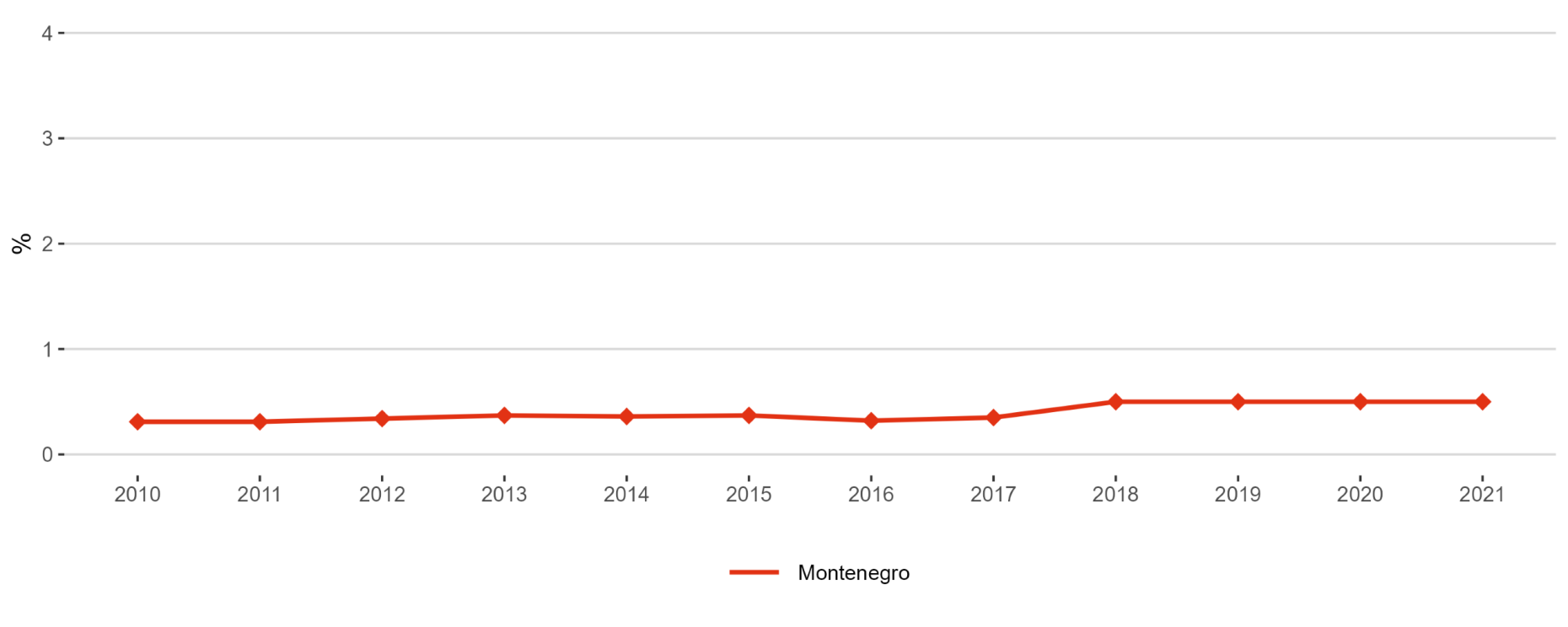
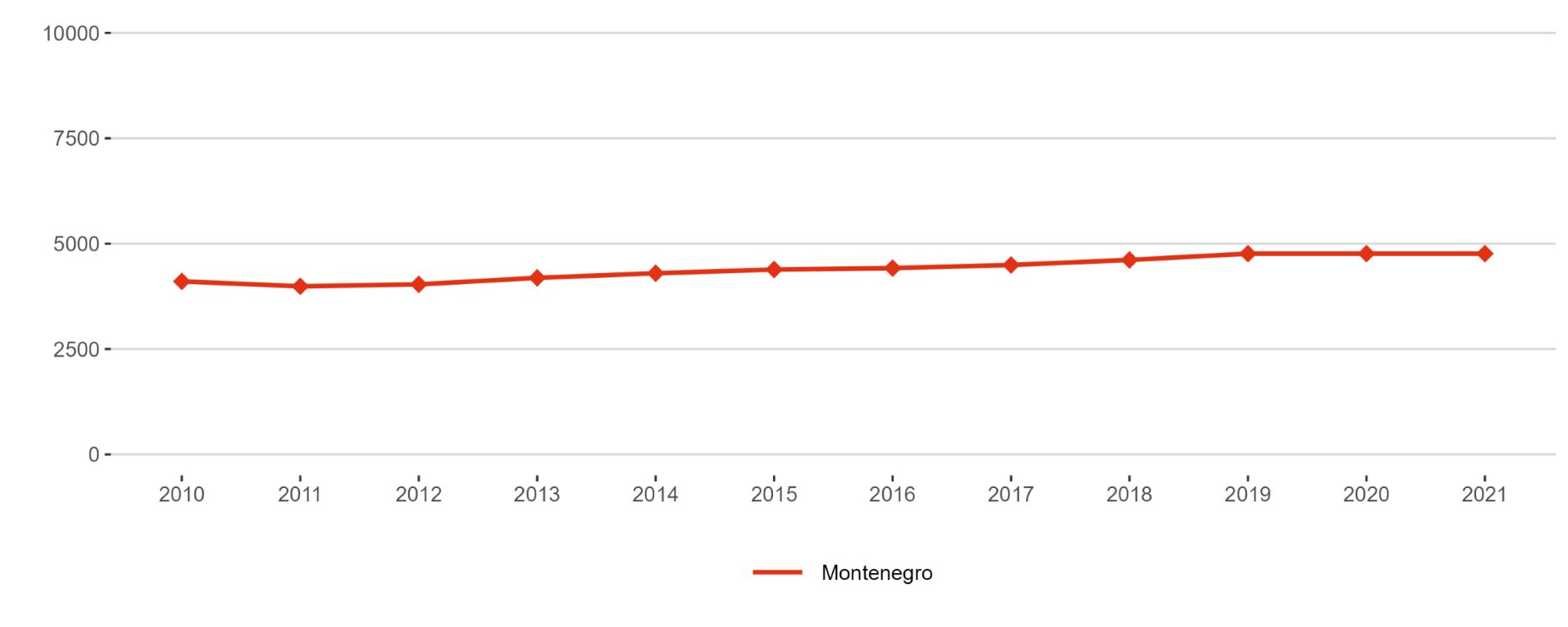

Priority 1: Deepening a truly functioning internal market for knowledge
Sub-priority 1.1: Open Science
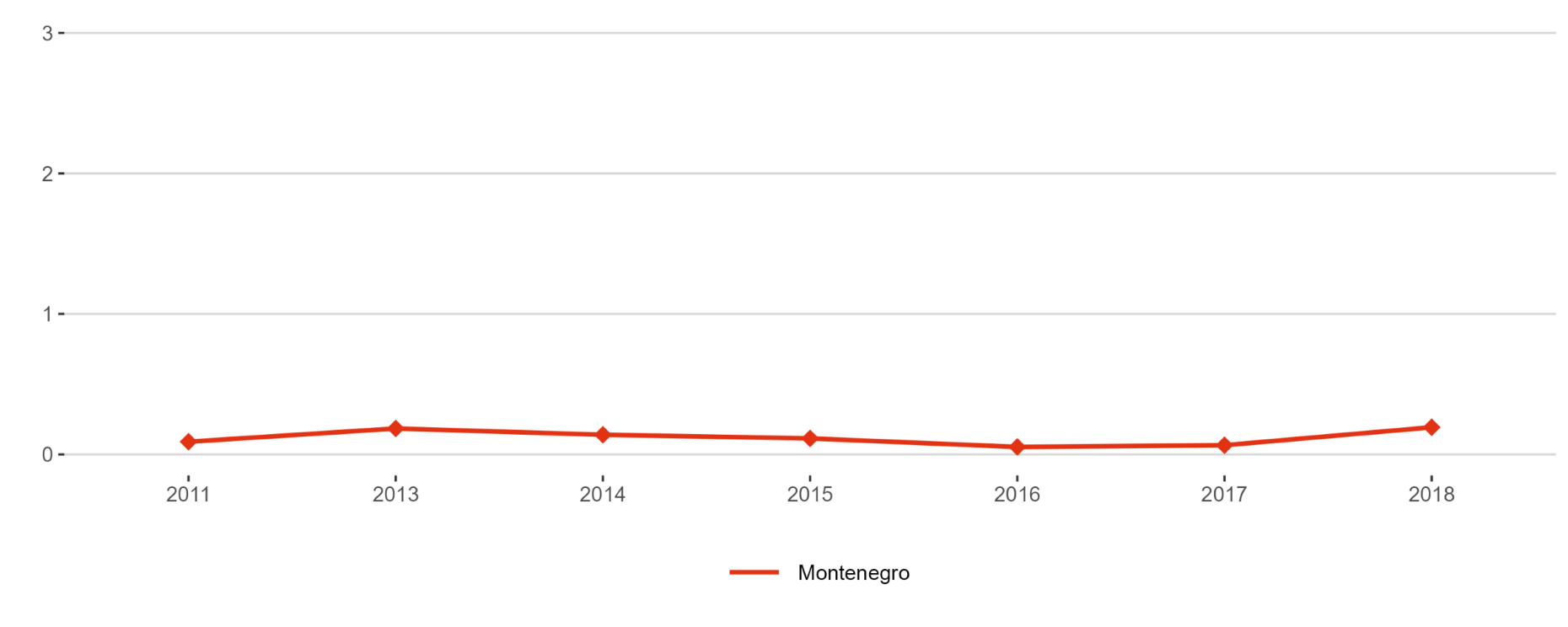
Sub-priority 1.3: Gender equality, equal opportunities for all and inclusiveness
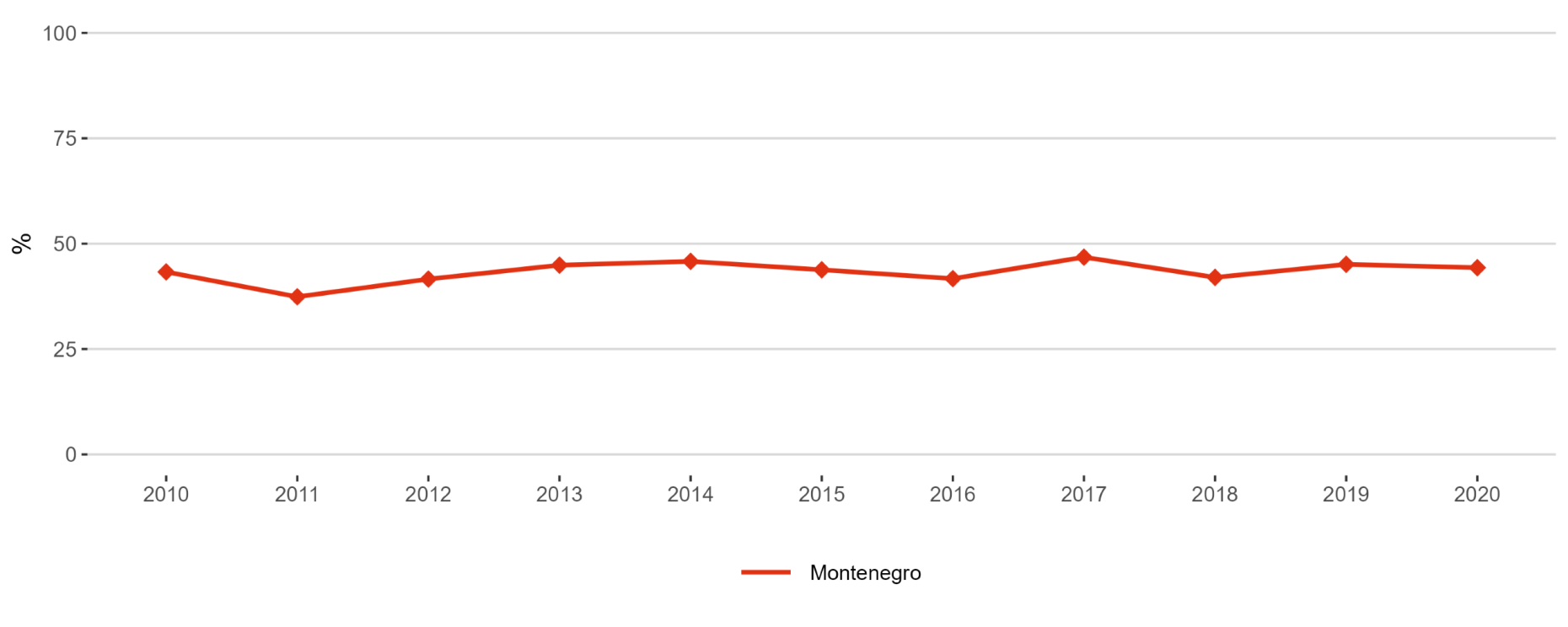

Sub-priority 1.4: Researchers’ careers and mobility and research assessment and reward systems
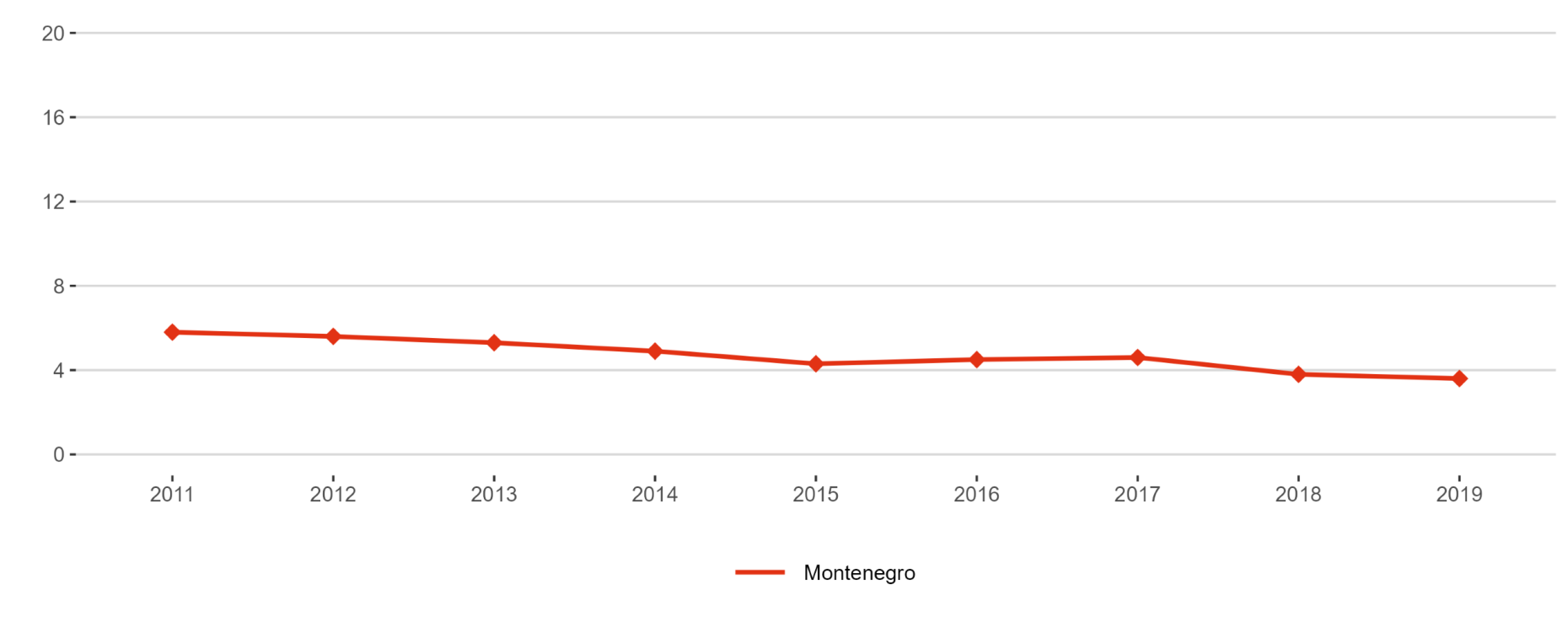
Sub-priority 1.6: Scientific leadership
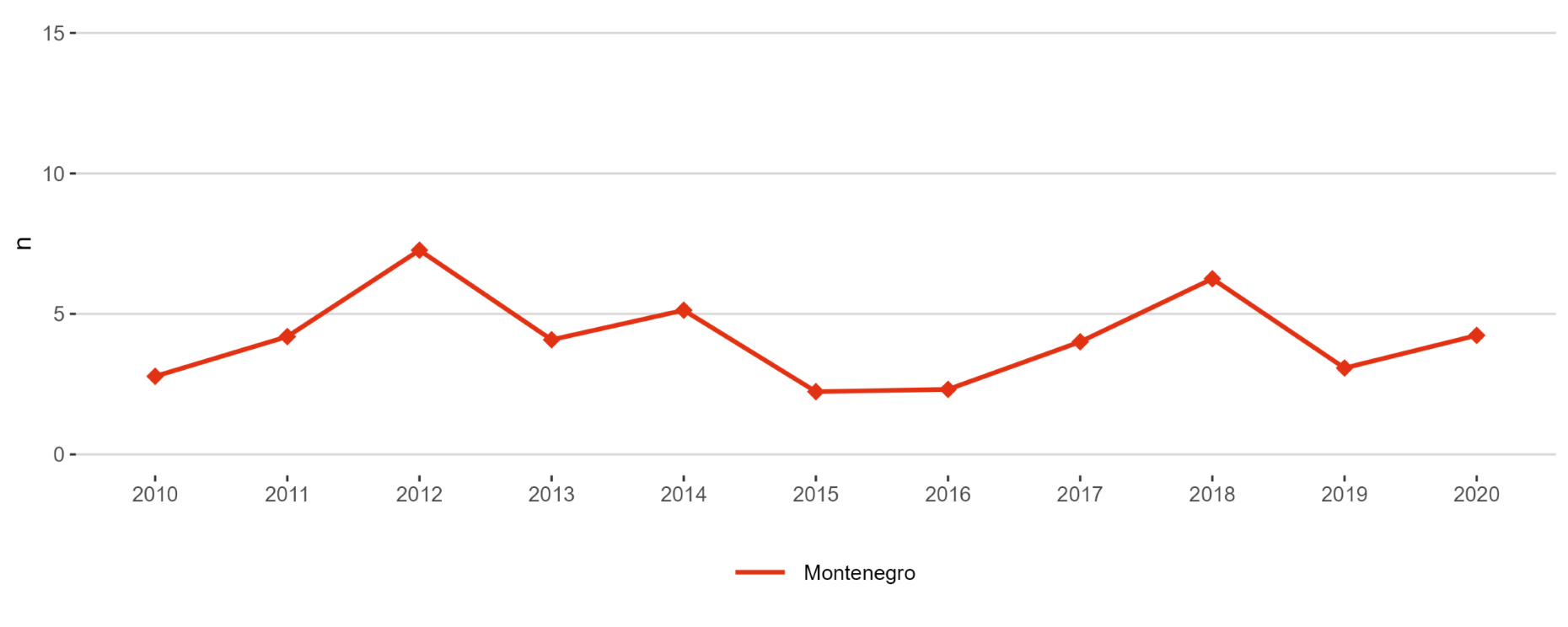
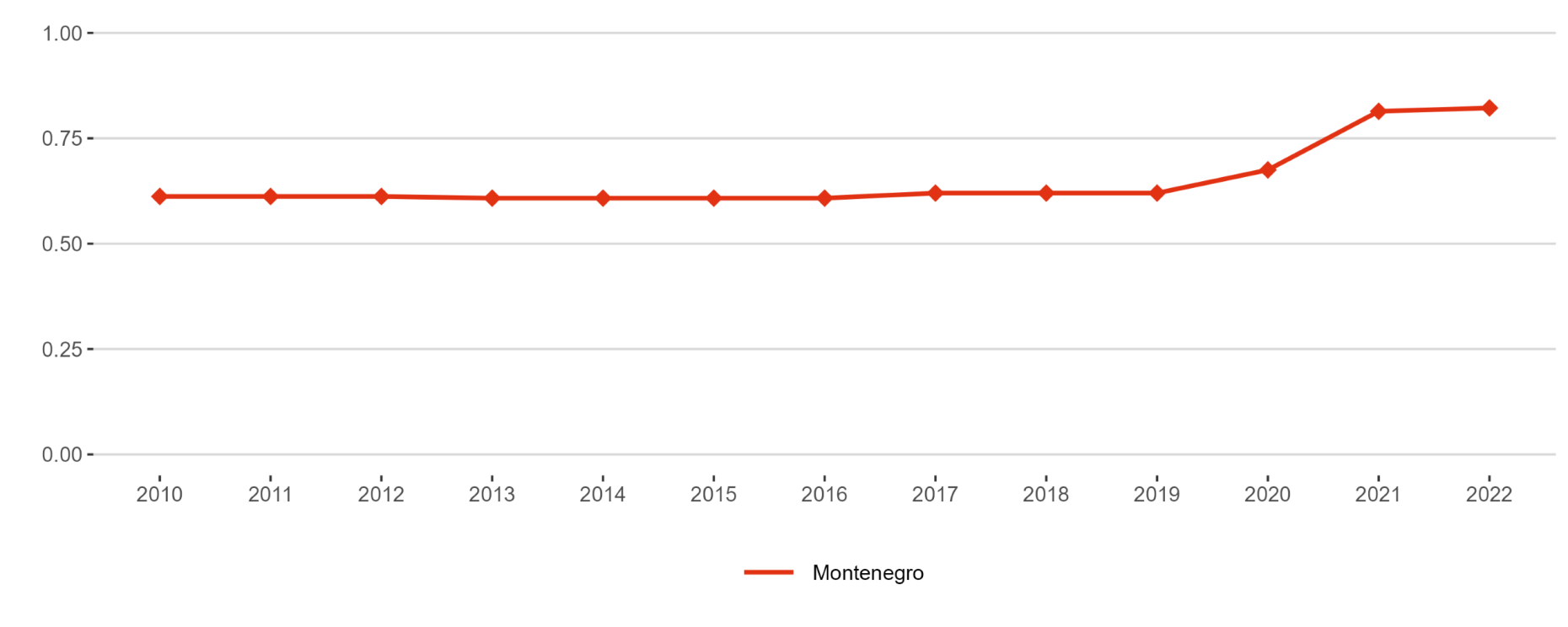
Sub-priority 1.7: Global engagement

Priority 2: Taking up together the challenges posed by the twin green and digital transition, and increasing society’s participation in the ERA
Sub-priority 2.1: Challenge-based ERA actions
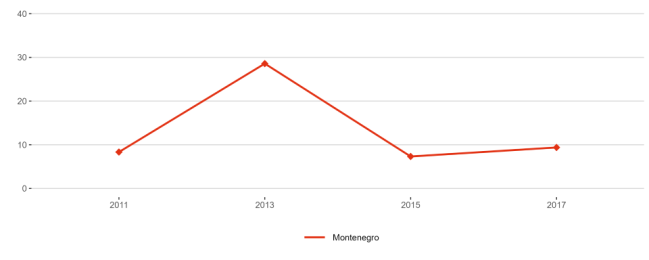
Sub-priority 2.3: Synergies with sectorial policies and industrial policy, in order to boost innovation ecosystems
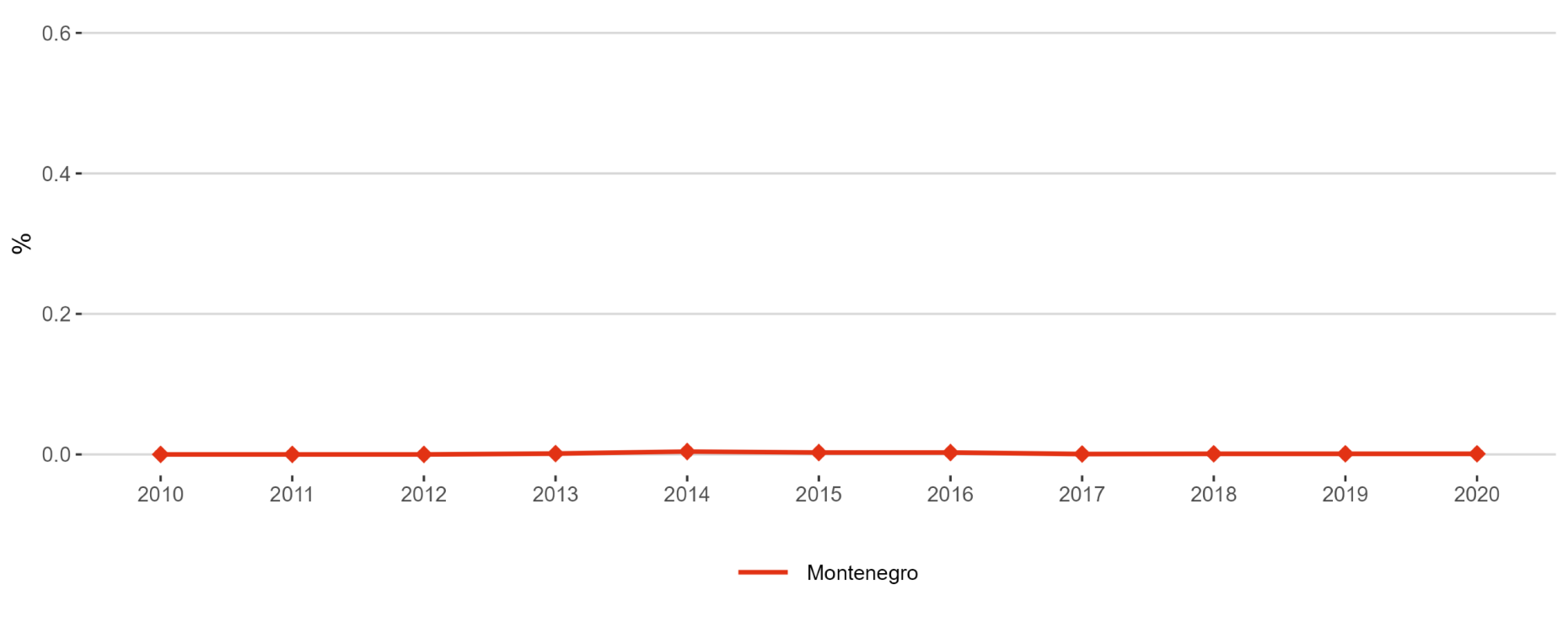
Sub-priority 2.4: An active citizen and societal engagement in R&I in all its dimensions

Priority 3: Amplifying access to research and innovation excellence across the Union
Sub-priority 3.1: More investments and reforms in countries and regions with lower R&I performance
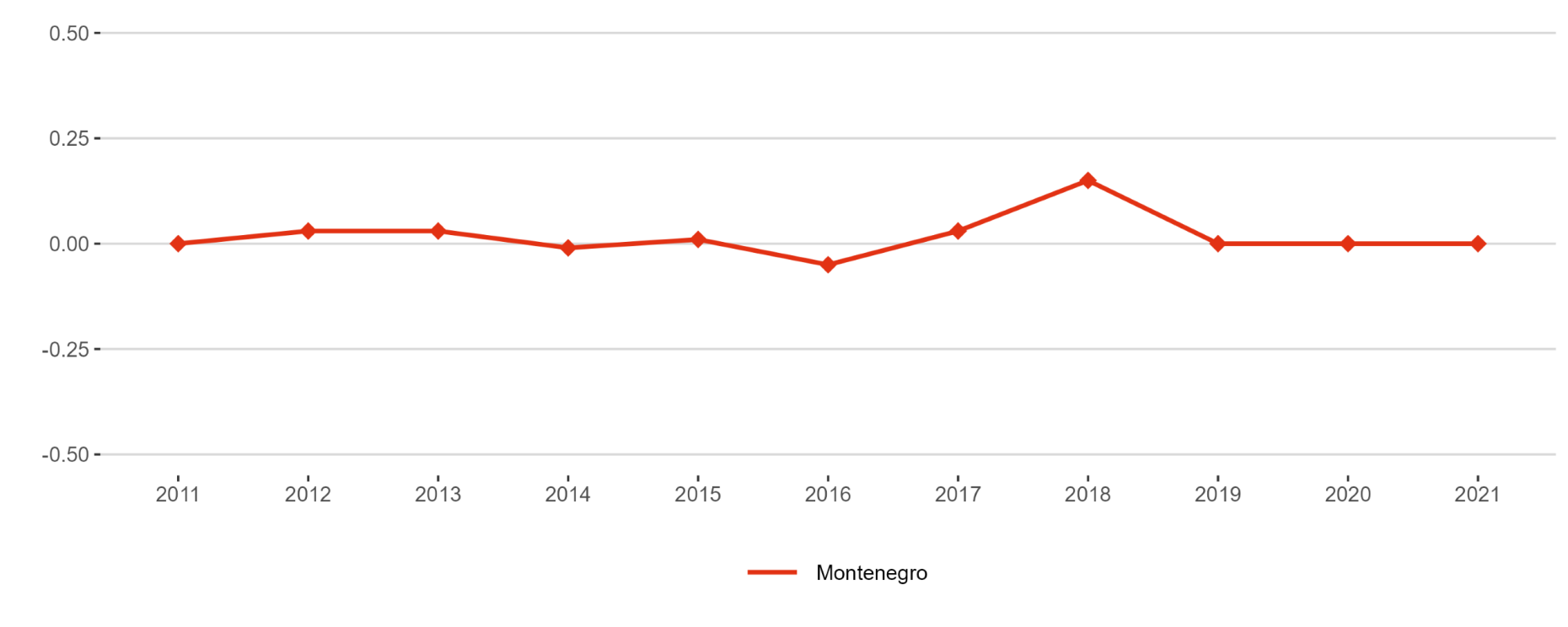
Priority 4: Advancing concerted research and innovation investments and reforms
Sub-priority 4.1: Coordination of R&I investments
